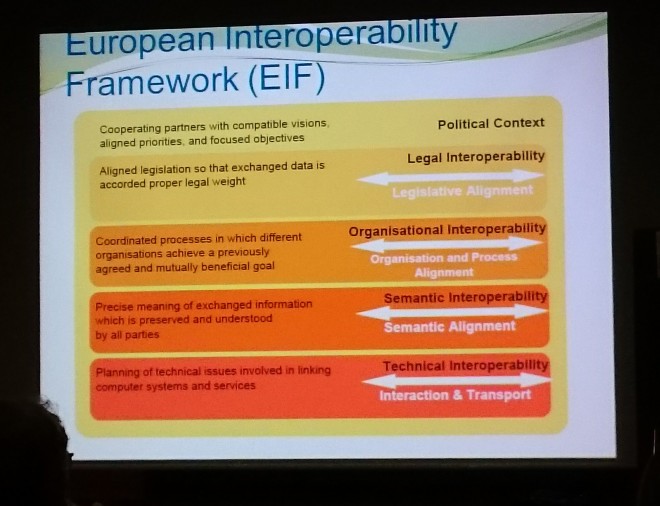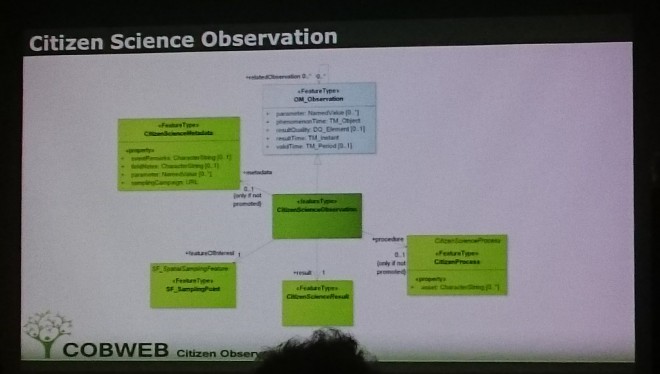Citizen Science Data & Service Infrastructure
Following the ECSA meeting, the Data & tools working group workshop was dedicated to progressing the agenda on data & infrastructure.
Jaume Piera (chair, Data and Tools working group of ECSA) covered the area of citizen science data – moving from ideas, to particular solutions, to global proposals – from separate platforms (iNaturalist, iSpot, GBIF, eBird) but the creation of different citizen science associations and the evolution of ideas for interoperability, can allow us to consider the ‘Internet of People# which is about participatory sharing of data. We can work in similar way to standards development in the area of the internet, and starting to consider the layers: interoperability, privacy/security, data reliability, infrastructure sustainability, data management, intellectual property rights, engagement, Human-Computer Interaction, Reference models and testing. By considering these multiple layers, we can develop a roadmap for development and consider a range of solutions at different ‘layers’. The idea is to open it to other communities – and aim to have solutions that are discussed globally.
Arne Berra explained the CITI-SENSE platform. There is a paper that explains the architecture of CITI-SENSE on the project site. He proposed that we use the European Interoperability Framework — legal, organisational, semantic and technical. in the technical area, we can use ISO 19119 and OGC – with 6 areas: boundary, processing/analytics, data/model management, communication, systems. We can use reference models. Also suggested considering the INSPIRE life cycle model. There is a challenge of adapting standards into the context of citizen science, so in many ways we need to look at it as conceptual framework to consider the different issues and consider points about the issues. In CITI-SENSE they developed a life cycle that looked at human sensor data services, as well as the hardware sensor application platform.
Ingo Simonis (OGC) – a standardised encoding to exchange citizen science data. He describe work that OGC is doing in sensor web for citizen science, and they collected data from different projects. Through citizen science data, information come from different surveys, in different forms and structures. The requirements are to have citizens + environment + sensor. Who did particular measurement? We want to know about the environment – e.g. that it was rainy while they collected the data, and then know about the sensor. So OGC O&M citizen observatories model is conceptual. It’s an observation model – assigning a value to a property – they also look at standards for sensors – OGC SensorML. He used the ISO 19100 series of standards. The observation model is trying to address issues of observations that are happening offline and then being shared. The model also deal with stationary and mobile sensing activities, and allowing for flexibility – for example having ad-hoc record that is not following specific process.
Alex Steblin – The Citclops project includes applications such as Eye on Water (eyeonwater.org). The Citclops have a challenge of maintaining the project’s data once the project finished.
Veljo Runnel covered EU BON work (www.eubon.eu) – mobilising biodiversity ata is challenges. They want a registry of online tools for citizen science projects – tool that will allow people who work with citizen science to record information about the project as related to biodiversity – such as link to GBIF, recording DNA, use of mobile app. Finding the person that run the tool is difficult. On EU BON they have ‘data mobilization helpdesk’, the elements of the standard were discussed within the the EU BON consortium and how they are going to explore how to provide further input.
JRC is exploring the possibility of providing infrastructure for citizen science data – both metadata and the data itself.
Translation of technical information into a language that is accessible is valuable for the people who will be using it. We need to find way to make information more accessible and digestible. The aim is to start developing reference material and building on existing experiences – sub divide the working group to specific area. There are many sub communities that are not represented within the data groups (and in ECSA) and we need to reach out to different communities and have including more groups. There are also issues about linking the US activities, and activities from the small-scale (neighbourhoods) to large organisations. As we work through information, we need to be careful about technical language, and we need to be able to share information in an accessible way.


